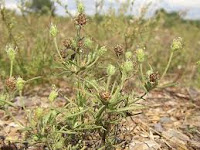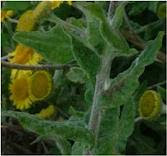The knotted figwort is so-called because of the knobbly bits that form on its roots. Perhaps it is called figwort because the immature flowers look like tiny figs before they bloom. It is a member of the Scrophulariaceae family which makes it a relative of mullein, toadflax, foxglove, eyebright, snap dragon and brahmi or water hyssop among other plants.
The name Scrophularia was given to this plant and the members of its family as it was believed that they could effect a cure for scrofula, which in the Middle Ages was known as the “King’s Evil” Morbus Regis in Latin. Scrofula is a tubercular swelling of the lymph glands, but in the 11th century, in England and France it was believed that the touch of the king could cure the disease. It began with Edward the Confessor, Edward I (1003/4 – 1066) and Philip I (1052-1108) of France . It was believed that the later generations of Kings inherited this royal touch which could cure the disease. When all else failed, I guess, the peasants turned to knotted figwort for a cure.
 During the Renaissance, and perhaps much earlier, it was recommended that this figwort was taken both internally and externally with the tisane of the root or the pounded root placed on the skin to get rid of all abscesses, sores, psoriasis, eczema and any other skin problem. The Romans used it for piles.
During the Renaissance, and perhaps much earlier, it was recommended that this figwort was taken both internally and externally with the tisane of the root or the pounded root placed on the skin to get rid of all abscesses, sores, psoriasis, eczema and any other skin problem. The Romans used it for piles. In Welsh it was called Deilen Ddu, the good leaf, which shows the high repute in which this figwort was held. In Ireland it was known as Rose Noble and throatwort. In French it is the herbe du siège referring to the fact that the tuberous roots of this plant were eaten by the people of La Rochelle during the siege of the city by Richelieu ’s troops in 1628.
(The roots are edible but do not taste good, so are only utilized as food in extremis.)
Nicholas Culpeper, writing his herbal in the 17th century had this to say about the health benefits of figwort:-
 “Government and virtues. Some Latin authors call it cervicaria, because it is appropriated to the neck; and we, throatwort, because it is appropriated to the throat. Venus owns the herb, and the Celestial Bull will not deny it; therefore a better remedy cannot be for the king's evil, because the Moon that rules the disease, is exalted there. The decoction of the herb taken inwardly, and the bruised herb applied outwardly, dissolves clotted and congealed blood within the body, coming by any wounds, bruise or fall; and is no less effectual for the king's evil, or any other knobs, kernels, bunches, or wens growing in the flesh wheresoever; and for the hæmorrhoids, or piles. An ointment made hereof may be used at all times when the fresh herb is not to be had. The distilled water of the whole plant, roots and all, is used for the same purposes, and drieth up the superfluous virulent moisture of hollow and corroding ulcers; it taketh away all redness, spots, and freckles in the face, as also the scurf, and any foul deformity therein, and the leprosy likewise.”
“Government and virtues. Some Latin authors call it cervicaria, because it is appropriated to the neck; and we, throatwort, because it is appropriated to the throat. Venus owns the herb, and the Celestial Bull will not deny it; therefore a better remedy cannot be for the king's evil, because the Moon that rules the disease, is exalted there. The decoction of the herb taken inwardly, and the bruised herb applied outwardly, dissolves clotted and congealed blood within the body, coming by any wounds, bruise or fall; and is no less effectual for the king's evil, or any other knobs, kernels, bunches, or wens growing in the flesh wheresoever; and for the hæmorrhoids, or piles. An ointment made hereof may be used at all times when the fresh herb is not to be had. The distilled water of the whole plant, roots and all, is used for the same purposes, and drieth up the superfluous virulent moisture of hollow and corroding ulcers; it taketh away all redness, spots, and freckles in the face, as also the scurf, and any foul deformity therein, and the leprosy likewise.” Figwort is native to
Figwort is native to  The plant contains saponins, hesperidin, cardio-active glycosides, anti-inflammatory glycosides, alkaloids, flavonoids, iridoids and other substances which contribute to its actions. Harpagoside, an iridoid, is found in the knotted figwort, which is also present in devil’s claw, and is believed to have anti-inflammatory action of use in the treatment of arthritis.
The plant contains saponins, hesperidin, cardio-active glycosides, anti-inflammatory glycosides, alkaloids, flavonoids, iridoids and other substances which contribute to its actions. Harpagoside, an iridoid, is found in the knotted figwort, which is also present in devil’s claw, and is believed to have anti-inflammatory action of use in the treatment of arthritis. Diosmin, a flavonoid glycoside, is also present and this is believed to have a vascular-protecting action. The flavonoids present in the plant mean that it has antioxidant properties, anti-mutagenic actions and anti-inflammatory ones too.
 It is a heart stimulant and has antibacterial and antifungal properties, according to one study. It is believed to have a stimulating effect on blood circulation too, but more research needs to be done into the plant before scientists can positively identify the reasons for its apparent actions.
It is a heart stimulant and has antibacterial and antifungal properties, according to one study. It is believed to have a stimulating effect on blood circulation too, but more research needs to be done into the plant before scientists can positively identify the reasons for its apparent actions.














































